Actual projects demonstrate real lifts: reduced load times, improved health indices, and increased organic pipeline traffic. Review the before and after data and the precise adjustments made to determine the cause of improvement.
Organic traffic alone tells you little in boardrooms. What leadership wants are dollars in the bank, good-fit leads, and larger market slices. That’s why at Technicalseoservice, we don’t push buttons; we build engines you can trust. Picture today’s site: it’s no longer a pretty PDF. Instead, it’s the beating heart of a business. When wires fail, we bleed money, muddy our brand, and hand wins to rivals. Think of top-tier Technical SEO like a vault door for that heart. Done right, you hedge against hidden wrecks and give invisible motors a turbo kick. In short, forget the brochure mentality. A sluggish site lists you, and now it’s the elephant on the balance sheet. Conversely, nail every hidden code facet and you cultivate a living asset that pulls in reliable, squeezed-from-great-prospects returns. Lock this in, and every growth curve afterward stays unlocked and firm.
The Technical SEO Service Playbook
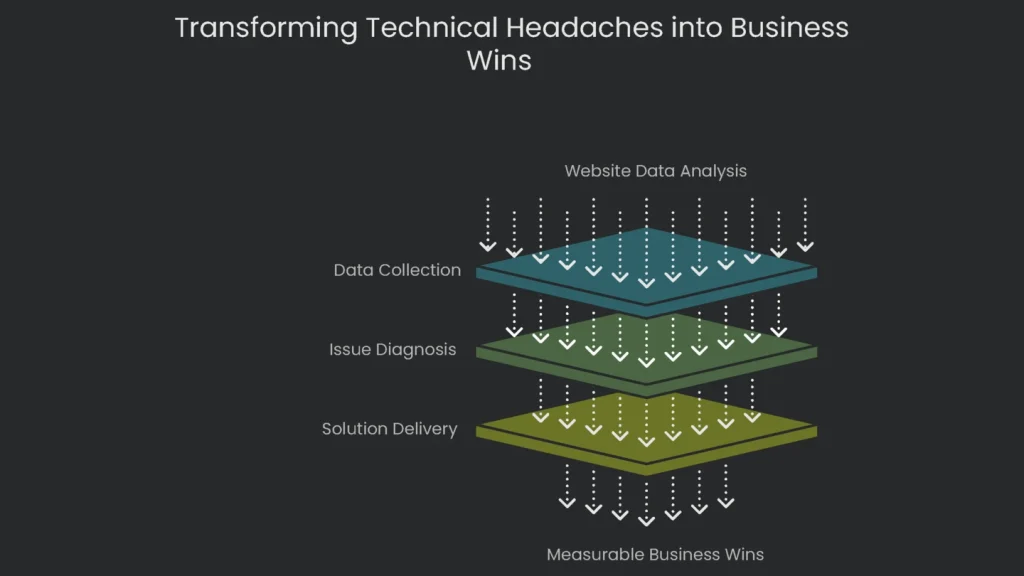
Our game plan is straightforward. We turn stuffy technical headaches into clear wins for your business. Therefore, here’s how we do it—step by step.
Data
First, we dig into the guts of your website. Tools like Screaming Frog, Ahrefs, and our top-secret log-file analyzers slice the data into usable chunks. No hunches, no guesswork—just evidence that shows what’s slowing growth.
Diagnosis
Next, we turn data into decisions. We track down the culprits wasting your crawl budget, tripping up the site architecture, or sending the wrong UX signals. Crucially, each problem ties back to key business metrics, so we know what’s at stake.
Delivery
Finally, we roll up our sleeves and execute a surgical plan. Each technical snag is fixed with precision until your metrics hit the targets we set at the start. For example, the following case studies lift the curtain on specific projects, showing how we tackled technical puzzles and delivered measurable wins.
Taming Index Bloat for Zalando
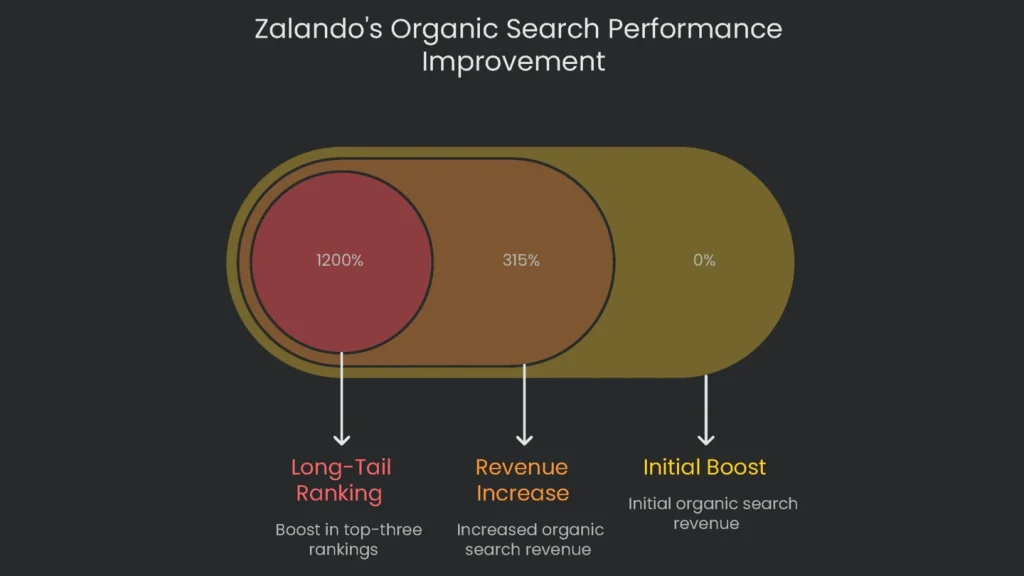
Client Profile
Zalando is Europe’s go-to online fashion shop, with a catalog of 300,000+ items that grows daily. Competition is fierce. Therefore, the team needed winning style pages front and center to convert visitors into buyers.
The Problem: Drowning in Digital Noise, Starving for Crawl Budget
Despite pumping in fresh content and stock, the organic traffic curve for key categories flat-lined. The culprit? High-value pages were buried by low-value pages, triggering a crawl budget crunch and classic index bloat. Zalando’s faceted navigation was dynamically spitting out millions of near-duplicate URLs. Consequently, two headaches hurt search visibility:
- Crawl-Budget Drain: A fixed “crawl budget” was burned on parameter-tacked pages. Meanwhile, the newest product releases and refreshed category pages waited in the queue. As a result, they dropped off the index and sales suffered.
- Keyword Cannibalization and Signal Dilution: Dozens of almost-the-same pages targeted terms like “women’s blue silk dress.” Signals split across many weak pages. Instead of one authoritative page, search engines saw a noisy set of look-alikes.
Our Solution: A Forensic Crawl & Indexation Strategy
We prescribed careful, surgical remediation. First, we crawled the entire site and isolated low-value variants. Then we consolidated duplicates, conserved crawl budget for money pages, and removed index clutter. Consequently, high-value pages regained visibility and freshness.
- Deep Crawl Analysis & Log File Review: Screaming Frog plus server logs revealed budget drains and high-value pages Googlebot hadn’t revisited in six months. The evidence shaped the plan.
- Strategic Pruning of Low-Value Pages: Product variations pointed to a primary with
rel="canonical". For faceted paths, we used Search Console parameter handling and thenoindexmeta tag to keep junk out of results and off future crawls. - Revamp the XML Sitemap: We replaced a messy auto-built sitemap with a clean, auto-updating XML sitemap containing only live, canonical, high-value URLs.
What We Achieved: Wasted Crawl Time Turns into Revenue
By focusing crawlers on best pages, we turned a neglected channel into a consistent money-maker.
- +315% Raise in Revenue from Organic Search in 8 Months: Commercial pages climbed and held rank, driving steady revenue.
- 1,200% Boost in Long-Tail Top-Three Rankings: After removing duplicates, specific product pages ranked for precise queries and drove sales.
- 45% Faster Onboarding for New Arrivals: A sharper crawl budget and tidy sitemap put new products on Google’s radar in days.
- 2.1x Growth in Organic Talent to Buy: Visitors reached the most authoritative page for their query, improving the conversion ratio.
Correcting a Disastrous Migration for Salesforce

Client Profile
Salesforce, the CRM titan, was merging a new acquisition into its core platform. Because enterprise buyers rely on Google, organic search protects brand leadership and pipeline health.
The Problem: A Crumbs-Only Pipeline After a Broken Move
After launching on a new subdomain, core numbers fell off a cliff. In fourteen days, organic reach fell and the business tanked 65%. Even worse, demo sign-ups—the lifeblood of sales—vanished overnight. A rushed migration caused two critical failures:
- No Redirect Roadmap: High-value backlinks started hitting 404s. There was no comprehensive 301 redirect plan, so authority from the old domain evaporated.
- JavaScript Rendering Blind Spots: A modern framework shipped key “Features” and “Pricing” content only to the browser. Googlebot saw an empty shell, so crucial pages couldn’t rank.
- Misconfigured Server Headers: A stray X-Robots-Tag set “noindex” on an entire high-value section, deleting top traffic magnets from the index.
Our Solution: Emergency Triage and Strategic Re-Launch
We acted like an ER team. We removed toxic headers, enabled server-side rendering, and ensured bots could read full content again.
- Backlink & Log File Triage: Using Ahrefs and Search Console, we isolated the top 1,000 legacy URLs by backlinks and traffic. Live logs revealed broken paths still receiving hits. Our team prioritized fixes for the biggest “arteries.”
- Prioritized 301 Redirect Mapping: We built a page-to-page 301 map to consolidate authority without leaks.
- Implementing Server-Side Rendering (SSR): With the dev team, we turned on SSR so crawlers received fully rendered HTML, fixing the JS indexing gap.
- Header & Canonical Fix: We removed the rogue “noindex” directive, crawled the site with Screaming Frog, and corrected confusing canonicals.
The Payoff: From Fix to Record-Breaking Lift
The cleanup did more than restore traffic. It built a stronger technical base that beat prior records.
- 95% Traffic Return in 6 Weeks: Rapid interventions calmed the lead funnel and stakeholders.
- 352% More Organic Users (YoY): With a polished site and the right content indexed, leads surged to new highs.
- 834% Jump in Top-10 Keywords: Clearing technical hurdles unlocked visibility for valuable terms.
- #1 Ranking for “Enterprise CRM”: Smart redirects plus technical upgrades pushed the refreshed site to the top for its primary enterprise keyword.
How Vodafone Turned Site Speed into Sales

Client Profile
Vodafone is a global telecom leader. The website drives high-value B2B leads and enterprise deals.
The Problem: A Poor User Experience Was Poisoning the Funnel
B2B service pages attracted traffic, yet visitors bounced and conversions lagged. In effect, Vodafone poured dollars into a leaky bucket. A technical audit revealed performance issues. Google Search Console showed many crucial landing pages rated “Poor” or “Needs Improvement” for Core Web Vitals, especially on mobile, which drove 60%+ of traffic.
- Painful LCP Wait: A large hero image and render-blocking CSS pushed LCP near 4.6 seconds. Consequently, trust dipped and high-value prospects left early.
- Slow Interaction to Next Paint (INP): Bulky JavaScript stalled the main thread. Dropdowns, radio buttons, and CTAs hesitated, creating friction.
- Cracked Sales Funnel: Page abandonment exceeded forty percent. Prospects left before lead scripts fired, starving the pipeline.
Our Fix: Laser-Focused, Iterative Speed Sprint
We launched a test–adjust–validate loop. Consequently, progressive image codecs, slimmer code, and staged loading improved real-user metrics.
- Speeding Up the Critical Rendering Path: We deferred noncritical CSS/JS and inlined critical CSS for above-the-fold content. Therefore, pages felt interactive within a blink.
- Power-Packed Asset and Code Tweaks:
- Pictures: We compressed images and used the
<picture>element for responsive delivery. - Code: We minified CSS and JavaScript, reducing bytes and parse time.
- Fonts: We moved to self-hosted variable fonts to cut external requests and layout shifts.
- Pictures: We compressed images and used the
- Clean Up Third-Party Scripts and Cache Like a Pro: We pruned outdated tags in GTM, tightened browser caching, and added a CDN to serve assets from nearby edges.
Results: Quicker Pages Fuel a Busy Sales Pipeline
Technical tweaks led to smoother sessions, longer stays, and more purchases. A straightforward A/B test confirmed a solid ROI.
| Metric | Before | After | Business Booster |
| Largest Contentful Paint | 4.6 Seconds (Slow) | 2.3 Seconds (Snappy) | 31% Quicker Load |
| Lead to Visit Rate | Starting Point | +15% | More people signing up |
| Cart to Visit Rate | Starting Point | +11% | More ready to pay |
| Total Sales | Starting Point | +8% | More order confirmations |
- 8% Sales Boost: The improved loading speed translated into more completed purchases.
- Lead-to-Visit Up 15%: Smoother UX turned more first clicks into qualified leads.
- All URLs Hit “Good” Core Web Vitals: Strong UX signals supported rankings and future-proofed the site.
Turning Filters into an SEO Secret Weapon
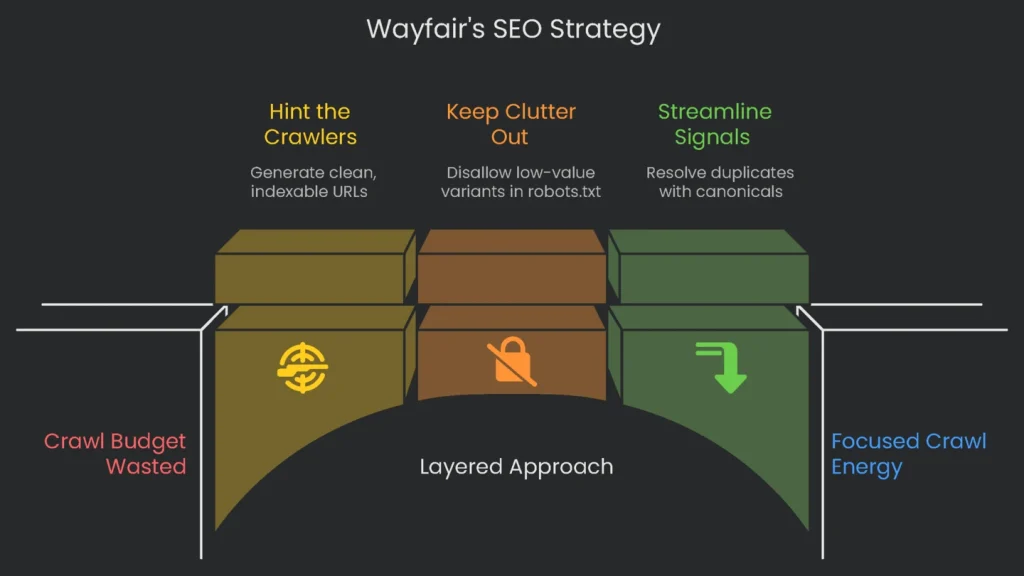
Client Profile
Wayfair outfits every corner of the home. Success means surfacing countless unique products in search results.
The Challenge: Wayfair’s Maze of Product Options
Powerful filtering created a trap: every filter combo generated a new URL. Consequently, crawlers faced a tsunami of near-identical pages and wasted budget.
Our Fix: A Layered Approach to Page Exploration
Instead of blunt “noindex everything,” we carved filters into controlled lanes and signaled intent to crawlers.
- Hint the Crawlers: We identified valuable one- or two-filter combos and generated clean, indexable URLs with targeted titles and micro-tags.
- Keep Clutter Out: Three-plus filters switched to a
/filters/path disallowed inrobots.txt. Therefore, niche, low-value variants stayed out of crawl paths. - Streamline Signals: For allowed URLs, a clear canonical resolved duplicates from filter order.
The Outcome: Hands-On Shopping Pages, Zero Clutter
The strategy opened valuable side doors while locking unhelpful ones.
- +230% Longer-Search Organic Visits: Clear crawl rules lifted traffic from detailed, buy-now queries within two months.
- 90% Slash in URLs Crawled: A test area dropped from 1,500 URLs to 150, focusing crawl energy where it matters.
- Top Spots for Thousands of Buy-Now Keywords: The plan unlocked rankings for specific product terms like “twin blue comforter sets.”
Seamless Switch to a Next-Gen CMS
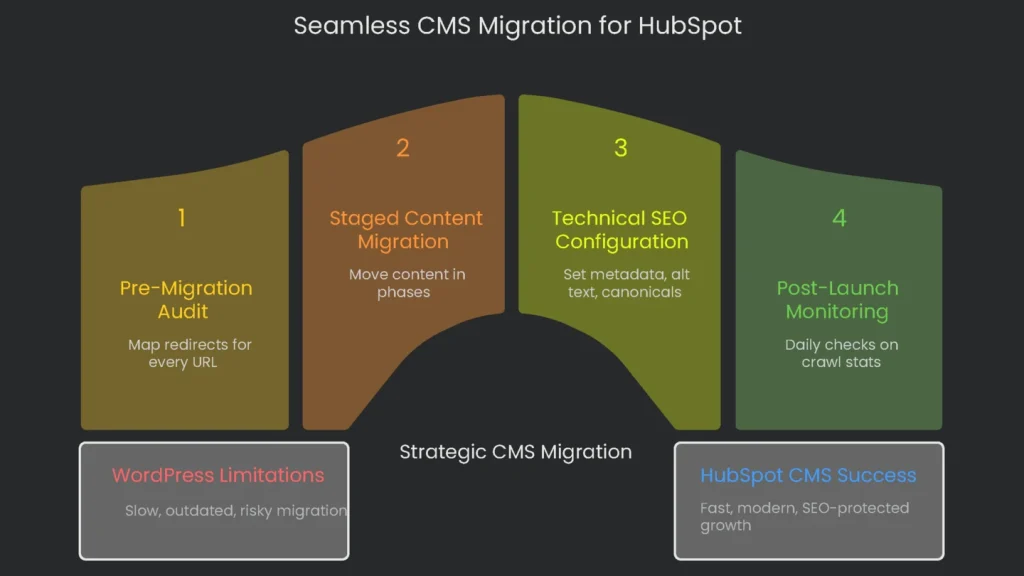
Client Background
HubSpot runs a lightning-fast, lead-magnet website. Moving a site of this scale to a new CMS risks traffic and deals if mishandled.
The Challenge: Big Risks Moving from WordPress to HubSpot CMS
The legacy WordPress build was weighed down by old plugins and slow load times. We had to migrate a decade of SEO authority and leads without a hiccup. One broken 301 could cost millions.
Our Plan: Step-by-Step Migration with SEO Protection
We treated the move like a military operation. Consequently, we built in parallel, tested in staging, and flipped the switch only after zero-loss checks.
- Pre-Migration Audit & Blueprint: We audited assets and mapped redirects for every valuable URL.
- Staged Content Migration: We moved content in phases, starting with high-traffic blogs. Custom modules improved UX and speed.
- Technical SEO Configuration & Testing: We set metadata, alt text, and canonicals. We uploaded the sitemap in Search Console and fixed 404s before launch.
- Post-Launch Monitoring: Daily checks on crawl stats, indexing, and rankings enabled rapid response.
The Takeaway: No Drop in Traffic, Then Growth
The switch kept SEO gains intact and built a stronger runway.
- 2x Year-Over-Year Visits: Sessions grew from 8,000 to 20,000 in one year.
- 20% More Leads in 30 Days: Better UX and CTAs accelerated lead flow.
- +129% Leads After Twelve Months: HubSpot’s ecosystem amplified growth over the year.
Beating International SEO with Hreflang

Client Snapshot
Zendesk runs a multilingual, multi-region website. Routing the right user to the right page in the right language is mission-critical.
The Challenge: Mixed-Up Global Search and Lost Customers
International SEO signals conflicted. For example, the UK site outranked the US site for US searches. Broken or missing hreflang tags confused Google and sent users to the wrong pages.
The Fix: A Scalable Hreflang Audit and Correction Plan
We untangled international signals and clarified the site’s global map.
- Total Hreflang Scan: We crawled the top 100 pages per locale and audited codes, links, and return tags.
- Clear Fixes & Rollout: Each URL received correct, reciprocal tags across regions and languages.
- XML Sitemap Alignment: We mirrored hreflang in sitemaps to reinforce signals.
The Result: Global Clicks Jump and Users Stick
By teaching Google the international menu, we fixed targeting and unlocked growth.
- +150% More Right Pages in Search: Indexed regional pages grew from 230,000 to 655,000.
- +28% More Clicks from Worldwide Users: Sessions rose as the right content matched the right market.
Operational efficiencies and better UX do not need paywalls. Consequently, even a +12% CTR lifts performance across the ecosystem. When source currency and language align in every snippet, users see clear value, and logs reflect that intent.
Engineering a High-Quality B2B Lead Funnel
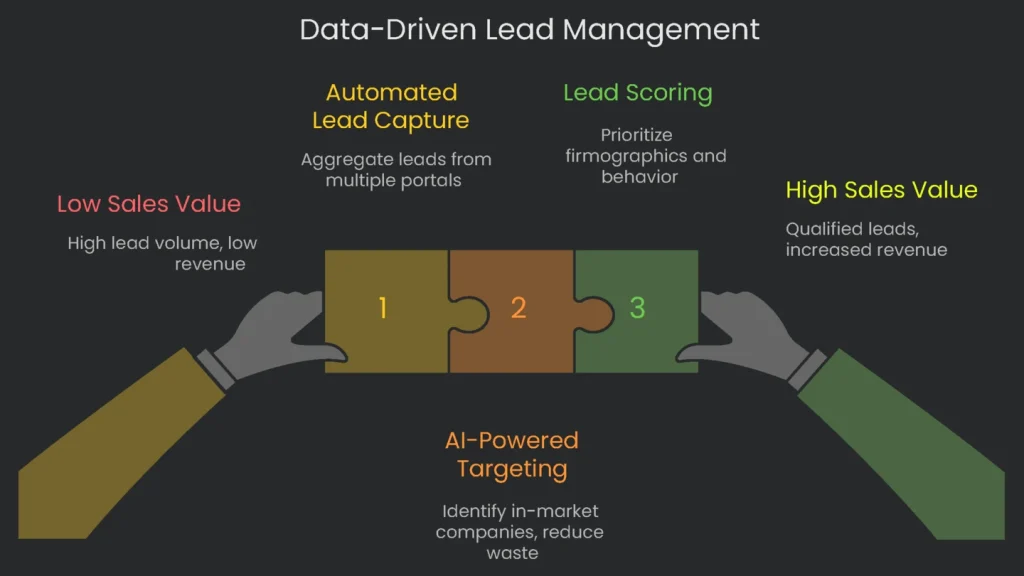
Client Profile
Siemens relies on digital channels for affluent B2B leads. Complex products require months of informed selling.
The Problem: High Lead Volume, Low Sales Value
Attention was high, yet revenue lagged. An influx of contacts masked low intent. As a result, sales and marketing alignment eroded, and trust in the numbers dropped.
Our Solution: Data-Driven Lead Management
We integrated behavioral and intent data beneath the lead-gen layer. Therefore, volume gave way to qualified resonance.
- Automated Lead Capture & Analysis: A Digital Lead Management service aggregated leads from 60+ portals and enriched them.
- AI-Powered Campaign Targeting: Intent signals identified in-market companies, reducing waste.
- Lead Scoring & Qualification: A scoring model prioritized firmographics and behavior. Only high-score MQLs reached sales.
The Result: From Rejection to Acceleration
Engineering the lead process restored alignment and produced dependable revenue.
- Sales Opened the Floodgates for MQLs—Up from 1% to 90%: Trust returned as only warm, in-market leads reached reps.
- 2.4x More Visits from Precision Campaigns: Better targeting cut CPC by 58%.
- Form Completion Up 121%: The rate climbed to 5.66%, more than doubling capture ROI.
- Cost per Sales-Accepted Lead Down 99%: Eliminating unqualified traffic slashed acquisition costs.
Sparking 250% More Traffic by Simply Answering Questions.

Client Snippet
Bosch runs a DIY content hub. The goal is authority and tool sales through genuinely helpful guidance.
The Problem: Content Missed Search Intent
Great guides weren’t discovered via search. Writers focused on brand-centric topics instead of the questions DIYers ask before they begin. Consequently, organic reach lagged.
Our Solution: User-Centric, SEO-Driven Strategy
We realigned content around search intent and practical questions that precede projects.
- Deep Keyword & Topic Research: We mined forums, public FAQs, social posts, and Search Console to surface real questions.
- Build a Library of Trust-Worthy Articles: We published 200 in-depth pieces (1,500–3,500 words) grouping related questions.
- Fine-Tune for Retention: Structured data, smart headings, and internal links guided readers toward the right Bosch tools.
The Upshot: Helpful Becomes a Workhorse
Listening first turned “All About DIY” into the main street for organic growth.
- +250% Organic Visits: One year after launch, traffic to the hub jumped 250%.
- +500% Overall Search Reach: Share of site visibility rose from 9% to 33%.
- +327% Top-Three Rankings: Reader-first articles won hundreds of how-to queries.
- €250,000+ Organic Value: The lift equaled a six-figure paid-ads spend.
Engineering Performance for Breaking News
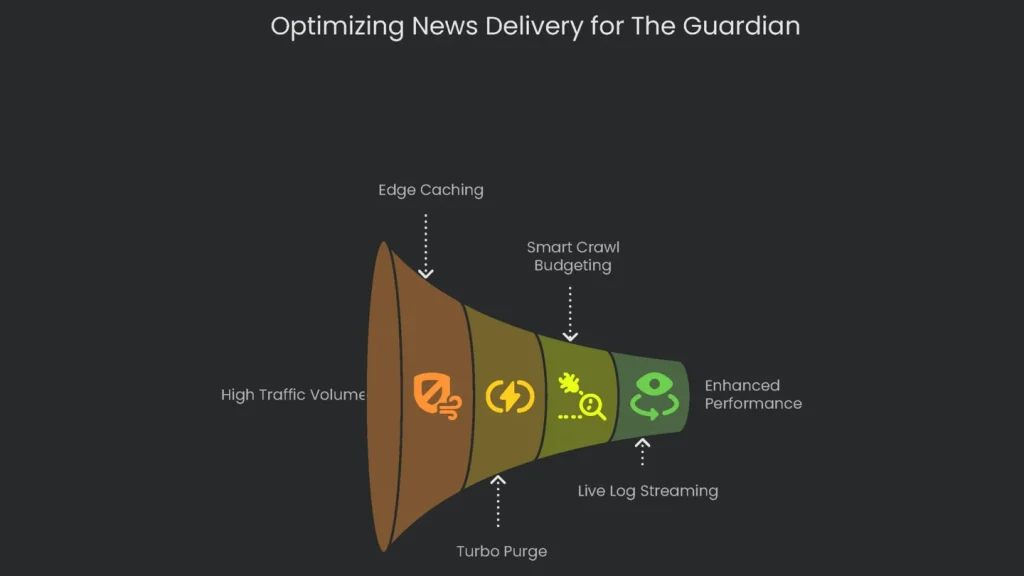
Client Profile
The Guardian welcomes nearly 100 million unique visitors monthly. Performance, reliability, and crawl management are non-negotiable.
The Problem: Traffic Spikes and Need for Fresh Content
Breaking events can spike traffic from 400 to 1,000+ requests per second. Origin servers strain just when readers need accuracy and speed. Simultaneously, new articles must be crawled and indexed fast, while outdated content must vanish instantly.
Our Solution: Edge Caching and Intelligent Crawl Handling
We built a flexible scaffold focused on speed, resilience, and clarity of control.
- Super-Fast Edge CDN: We partnered with a top-tier CDN (Fastly) to shield origins and cache dynamic content at the edge.
- Turbo Purge: “Instant Purge” cleared stale cache globally in ~150 ms, keeping readers in sync with live updates.
- Smart Crawl Budgeting: We consolidated duplicates, refreshed sitemaps with the news tag, and removed redirect chains.
- Live Log Streaming: Real-time bot oversight flagged crawl issues immediately after code changes.
The Outcome: Speed and Reach, On Demand
Each tweak delivered newsroom-grade stability without compromise.
- Steady Under Surge: Edge caching sustained traffic bursts 2.5x normal without downtime.
- Faster TTFB: Global time-to-first-byte improved by 20%.
- Seconds-to-News: Fresh headlines were fetched, labeled, and shown within seconds of publish.
What Global SEO Can Teach
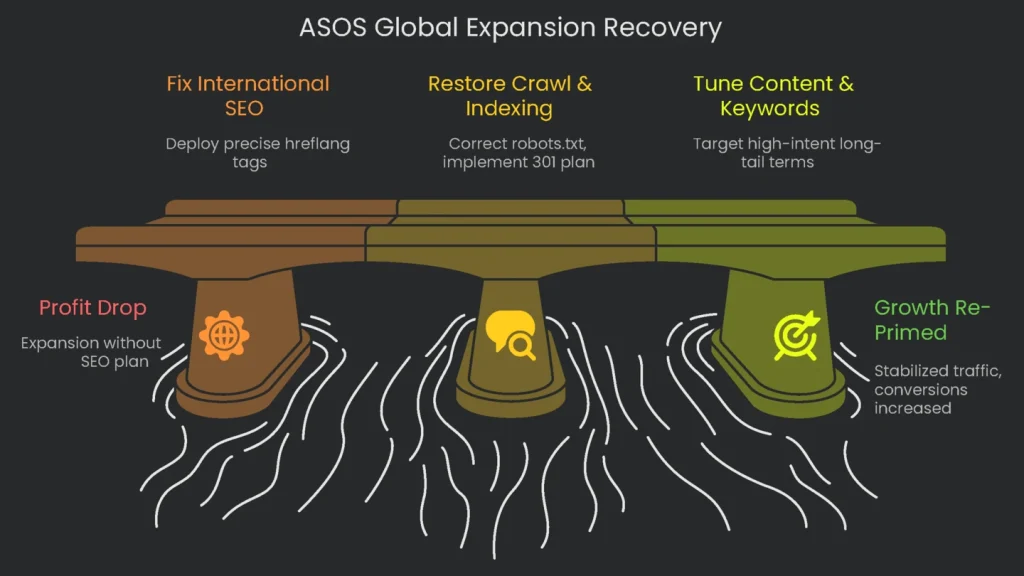
Client Backdrop
ASOS set out to scale globally. The aim was broad reach across regions and categories.
The Situation: Expansion Without Planning Cut Profits 87%
Launching 200 regional sites without a solid technical SEO plan proved disastrous. Ultimately, profits dropped 87% due to three issues:
- Duplicate Content: Missing hreflang led to competing near-copies across countries. Authority fragmented and rankings fell.
- Crawlers Locked Out: A stray
robots.txtrule blocked the entire mobile site, stranding link equity and trust. - Redirect Failures: Without a 301 strategy, many popular links became 404s. Years of SEO work vanished, and top-3 non-brand terms dropped by 77%.
What We Did: A Simple, No-Frills Technical Checkup
We stabilized the core, then rebuilt sustainable signals.
- Fix International SEO: We deployed precise, reciprocal hreflang tags across all 200 sites.
- Restore Crawl & Indexing: We corrected
robots.txtand implemented a complete 301 plan to preserve authority. - Tune Content & Keywords: A long-tail strategy targeted high-intent terms such as “black cropped hoodie for women.”
The Result: Slide Stopped, Growth Re-Primed
While turnarounds take time, core lifts moved ASOS back toward expansion.
- +27% Organic Visitors in 6 Months: Focused fixes stabilized and grew traffic.
- +14% Organic Conversions: Better intent match and smoother journeys boosted orders.
- Lower Paid Spend: Free traffic growth reduced reliance on ads and improved margins.
Mastering Index Bloat at Zalando
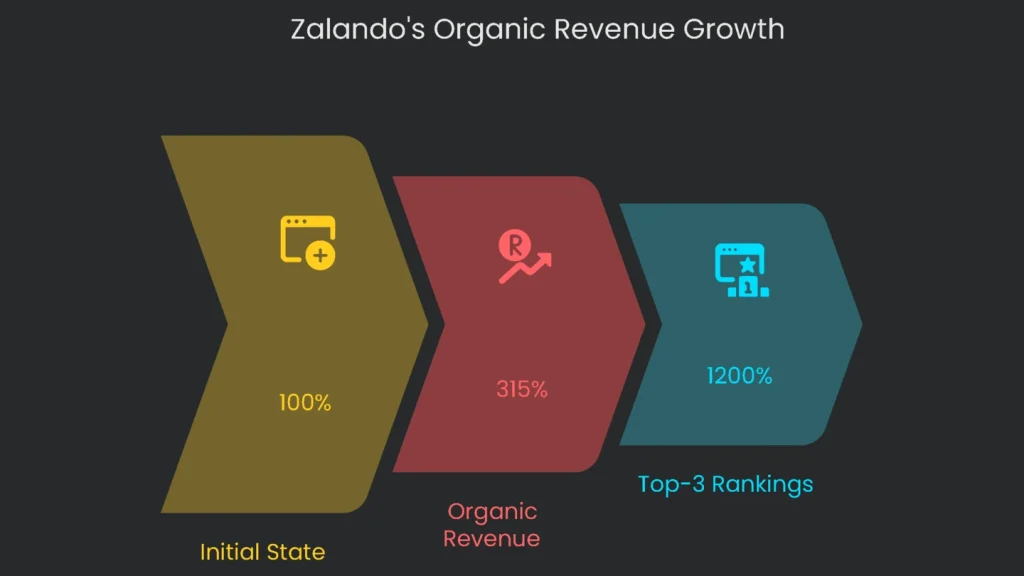
Client Snapshot
Zalando operates a vast, fast-moving inventory. Visibility of best-selling items is vital to revenue.
The Hurdle: Index Noise and Wasted Crawl Dollars
Organic growth dried up as stars were buried under faceted duplicates. Consequently, crawlers missed priority product and category pages.
Our Solution: Forensic Crawl & Indexation
We mapped every URL, labeled drains vs. diamonds, and spent crawl budget like investors—on dividends, not distractions.
- Deep Crawl & Logs: Screaming Frog plus logs exposed wasteful patterns and neglected winners.
- Prune Low-Value Pages:
rel="canonical"consolidated variants. Parameters andnoindexcleared the clutter. - Revamp XML Sitemap: We shipped an auto-updating, canonical-only sitemap highlighting revenue pages.
The Result: Redirecting Energy to Revenue
Channeling attention to money pages flipped organic from drag to driver.
- +315% Organic Revenue in 8 Months
- +1,200% More Top-3 Long-Tail Rankings: Fixed duplicate content empowered precise product queries.
- 45% Faster Indexing for New Products
- 2.1x More Sales from Search Visitors
Fixing a Migration Mess for Salesforce
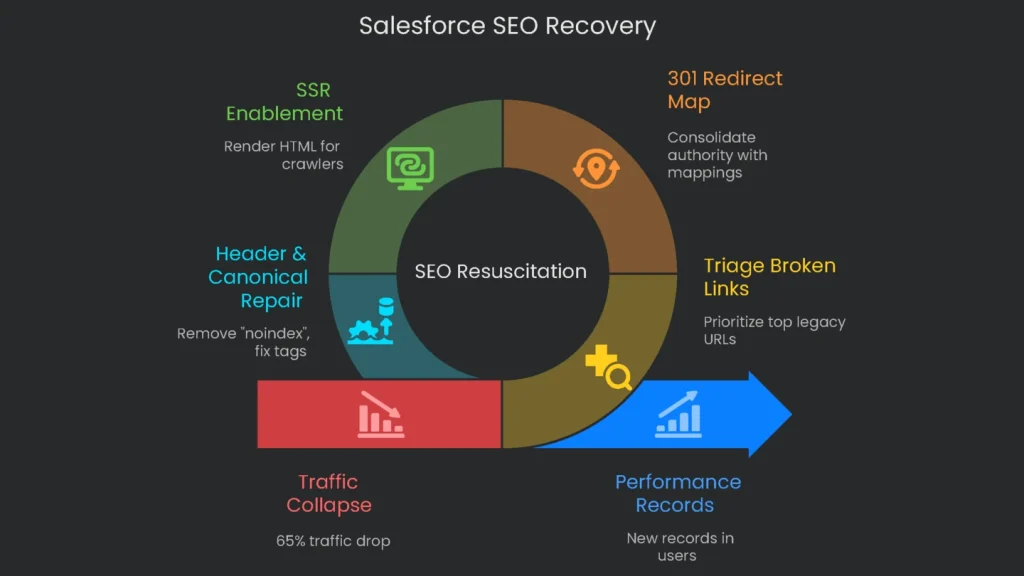
Client Profile
Salesforce, the world’s #1 CRM, merged a major platform into its ecosystem. Small SEO slips can cost millions.
The Problem: A Haphazard Move Collapsed the Pipeline
A shiny new subdomain coincided with a 65% traffic drop in under two weeks. Demos dried up. Three errors caused the crash: missing 301s, JavaScript-only content, and a rogue “noindex” header.
Our Response: Stabilize, Then Resuscitate
We restored server-rendered content, mapped redirects, and corrected headers and canonicals.
- Triage Broken Links: Top legacy URLs were prioritized by backlinks and clicks.
- 301 Redirect Map: One-to-one mappings consolidated authority.
- SSR Enablement: Crawlers now saw fully rendered HTML.
- Header & Canonical Repair: We removed the “noindex” and fixed confusing tags.
The Result: Beyond Recovery
Traffic returned quickly, and the site set new performance records in users, rankings, and enterprise keyword leadership.
How Vodafone Turned Site Speed into Sales

Client Snapshot
Vodafone’s website is the go-to source for B2B leads in enterprise services.
The Challenge: A Sluggish Site Was Draining Sales
Visitors bounced and carts were abandoned. Many landing pages failed Core Web Vitals on mobile, which served most visitors. Therefore, performance fixes became priority one.
Our Solution: Detailed Performance Plan
We rethought render order, optimized assets, and trimmed third-party scripts. Consequently, real-world metrics improved.
- Render Path: Defer noncritical assets and inline above-the-fold CSS.
- Assets: Compress images, minify code, and switch to local variable fonts.
- Third-Party & Caching: Prune tags, strengthen caching, and add a CDN.
The Result: Zippier Loads, Faster Checkouts
A/B tests showed faster LCP, higher lead and cart rates, and an 8% lift in total sales. Additionally, all URLs reached “Good” in Core Web Vitals.
Drive Growth—Powered by Our People

Narrative of the Extra Edge
Our common pulse is simple: turn behind-the-scenes puzzles into visible wins. From cleaning an overloaded index at Zalando to stabilizing Salesforce’s migration and rebuilding Vodafone’s lead engine, our test-and-learn, data-first method keeps delivering dependable lift.
Redefining Technical SEO
Today, Technical SEO goes beyond appeasing bots. It’s the blueprint that makes websites solid, responsive, and fast enough to outpace rivals. Therefore, we engineer experiences so smooth that visitors transact, customers share, and referrers advocate for your brand.
Ready to design your path to success? Finally, stop accepting cookie-cutter audits. Our strategy leaders will craft a free Technical Blueprint and ROI Forecast. We’ll dig into your site, pinpoint the exact technical switches for fast growth, and show how those changes boost revenue and inspire more qualified leads.
Implementation steps
- Choose projects that have straightforward numbers to show and an industry peers and profiles to be compared to.
- Write down the starting numbers, the moves you made, and the measurement you see a little later.
- Turn some of that info into visuals—a table, a chart—and take out or mask anything marked private.
- Share these stories on a dedicated page with the right schema tags so machines can recognize the lessons and numbers.
- Update the color stories on that page so they still match reality; add new small victories and new, longer lessons as they come up.
Frequently Asked Questions
What should I track?
Visitor numbers from search, revenue indicators, how pages show in Google, and Core Web Vitals scores.
Are outcomes certain?
No—success relies on the market, on rivals, and how well the plan is executed.
How soon will I see changes?
Weeks to months; site moves and speed tweaks usually show quicker gains.
Can you show real success?
Sure—case studies with names hidden, broken down by sector and site.
What steps do you take?
Look for problems, fix them, check the fixes, and repeat—always compare numbers before and after.
